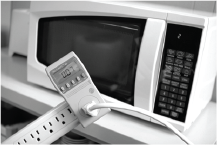Want to know the energy efficiency of your electronics? Check out a watt detector at your library and find out
Omaha Public Power District has partnered with libraries in our service territory to offer residents a way to measure how much electricity different appliances and electronics use. Just drop into your neighborhood library (see list below) and checkout a watt detector – then use it to save money on electric bills.
Studies show that people who use watt detectors to check energy usage can lower utility bills between 5% and 20% by noting when wattage is high and making changes to conserve energy. For more information on changes to lead to home energy savings, visit our Energy-Efficiency Tips section.
What is a watt detector – and how can it help you save on utility bills?
This video shows how the Kill-A-Watt device (aka: watt detector) is used to measure the amount of electricity various appliances and electronics use. This measurement is in kilowatts (kW). A watt detector lets you monitor or record your energy use – then find ways to conserve energy if it’s too high.
For example:
1,000 watts = 1 kilowatt
A 100-watt device running for 10 hours = 1 kW hour
This shows as cost per hour, day, week, month and year based on OPPD’s Residential Summer Rate of 9.4 cents per kW.

How to use a watt detector
- Plug the watt detector into a three-pronged outlet.
- Plug any two- or three-pronged appliance or device into the watt detector.
- Press and hold the RESET button until “rESt” appears.
- Use the MENU key to cycle through the options: Volt, Cost, Rate, KWH or Elapsed Time.
- Within the Cost or Volt category, use the UP and DOWN buttons to cycle through day, week, month or year.
- Keep the item plugged into the watt detector for at least one hour to get an accurate reading. For the most complete calculation, leave the item plugged in for 24 hours.
- If power is lost during calculation, the watt detector won’t give an accurate reading and will need to be reset, using steps 3 through 6.
Warning: To reduce the risk of fire or electric shock, do not expose this device to rain or moisture. Only appliances that use a standard 120-volt outlet can be measured, so do not plug in ranges, clothes dryers, refrigerators or other large appliances. Review the Operations Manual for all safety warnings.
PARTICIPATING LIBRARIES:
Agnes Robinson Waterloo Public Library
Ashland Public Library
Bellevue Public Library
Bennington Public Library
Blair Public Library
Ceresco Community Library
Creighton University - Reinert-Alumni Memorial Library
Elmwood Public Library
Falls City Library & Arts Center
Fort Calhoun Public Library
Greenwood Public Library
Gretna Public Library
Hooper Public Library
La Vista Public Library
Louisville Public Library
Mead Public Library
Nebraska City: Morton-James Public Library
North Bend Public Library
Omaha Public Library
Papillion: Sump Memorial Library
Ralston: Baright Public Library
Springfield Memorial Library
Syracuse Public Library
Tecumseh Public Library
Valley Public Library
Wahoo Public Library
Weeping Water Public Library
Yutan Public Library